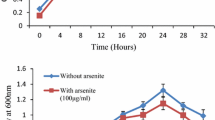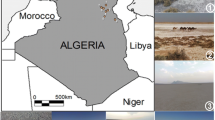Summary
Ten moderately halophilic spore-forming bacilli were isolated from saline soils in Iran and their intrinsic high-level resistance to chromate, arsenate, tellurite, selenite, selenate and biselenite was identified by an agar dilution method. Minimum inhibitory concentration (MIC) for each oxyanion was determined. All isolates were resistant to higher concentrations of arsenate. The resistance level of the isolates to selenooxyanions was between 10 and 40 mM. Maximum and minimum tolerance against oxyanions was seen in selenite and biselenite, respectively. Although toxic metal resistance in the isolates was not different from non-halophilic bacteria that has been reported, unusual resistance to arsenate (250 mM), sodium chromate (75 mM) and potassium chromate (70 mM) was observed. The results obtained in this study revealed that all isolates were obviously susceptible to silver, nickel, zinc and cobalt, while seven isolates were resistant to lead. Susceptibility to copper and cadmium varied among the isolates. Silver had the maximum toxicity, whereas lead and copper showed minimum toxicity. The impact of salinity on the toxicity of oxyanions was also studied. Our results showed that in general an increase in salinity from 5% (w/v) to 15% (w/v) enhanced tolerance to toxic oxyanions.
Similar content being viewed by others
References
M.A. Amoozegar F. Malekzadeh K.A. Malik P. Schumann C. Spröer (2003) ArticleTitleHalobacillus karajensis sp. nov., a novel moderate halophile International Journal of Systematic and Evolutionary Microbiology 53 1059–1063 Occurrence Handle10.1099/ijs.0.02448-0 Occurrence Handle1:CAS:528:DC%2BD3sXmsF2itro%3D
G.A. Burton T.H. Gidding P. Debrine R. Fall (1987) ArticleTitleHigh incidence of selenite-resistant bacteria from a site polluted with selenium Applied and Environmental Microbiology 53 185–188 Occurrence Handle1:CAS:528:DyaL2sXotFCqsg%3D%3D
J. Kessi M. Ramuz E. Wehrli M. Spycher R. Bachofen (1999) ArticleTitleReduction of selenite and detoxification of elemental selenium by the phototrophic bacterium Rhodospirillum rubrum Applied and Environmental Microbiology 65 4734–4740 Occurrence Handle1:CAS:528:DyaK1MXnt1Wmt78%3D
B.K. Kinkle M.J. Sadowsky K. Johnstone W.C. Koskinen (1994) ArticleTitleTellurium and selenium resistance in Rhizobia ands its potential use for direct isolation of Rhizobium meliloti from soil Applied and Environmental Microbiology 60 1674–1677 Occurrence Handle1:CAS:528:DyaK2cXjtFOmsrw%3D
J. McLean T.J. Beveridge (2001) ArticleTitleChromate reduction by a Pseudomonad isolated from site contaminated with chromated copper arsenate Applied and Environmental Microbiology 67 1076–1084 Occurrence Handle10.1128/AEM.67.3.1076-1084.2001 Occurrence Handle1:CAS:528:DC%2BD3MXhslSjsrk%3D
M. Mgharaj S. Avudainayagam R. Naidu (2003) ArticleTitleToxicity of hexavalent chromium and its reduction by bacteria isolated from soil contaminated with tannery waste Current Microbiology 47 51–54
J.J. Nieto R. Fernandez-Castillo M.C. Marquez A. Ventosa E. Quesada F. Ruiz-Berraquero (1989) ArticleTitleSurvey of metal tolerance in moderately halophilic eubacteria Applied and Environmental Microbiology 55 2385–2390 Occurrence Handle1:CAS:528:DyaL1MXlvFWgtb4%3D
J.O. Nriagu J.M. Pacyna (1988) ArticleTitleQuantitative assessment of worldwide contamination of air, water and soils by trace metals Nature 333 134–139 Occurrence Handle10.1038/333134a0 Occurrence Handle1:CAS:528:DyaL1cXktFSqsrw%3D
A. Oren (2002) Halophilic Microorganisms and their Environments Kluwer Academic Publishers Dordrecht, The Netherlands
P. Pattanapipitpaisal N.L. Brown L.E. Macaskie (2001) ArticleTitleChromate reduction and 16S rRNA identification of bacteria isolated from a Cr(VI)-contaminated site Applied Microbiology and Biotechnology 57 257–261 Occurrence Handle1:CAS:528:DC%2BD3MXotVSmsL4%3D
C. Rathgeber N. Yurkova E. Stackebrandt J.T. Beatty V. Yurkov (2002) ArticleTitleIsolation of tellurite- and selenite-resistant bacteria from hydrotermal vents of the Juan de Fuca Ridge in the pacific ocean Applied and Environmental Microbiology 68 4613–4622 Occurrence Handle10.1128/AEM.68.9.4613-4622.2002 Occurrence Handle1:CAS:528:DC%2BD38XmvVCjsLY%3D
Ríos, M., García, M.T., Arahal, D.R. & Ventosa, A. 2001 Salinivibrio kushnerii sp. nov., a new moderately halophilic species tolerant to chromium. In Proceedings of an International Conference on Halophilic Microorganisms held at Sevilla, Spain. p. 9
M.P. Souza A. Amini M.A. Dojka I.J. Pickering S.C. Dawson N.R. Pace N. Terry (2001) ArticleTitleIdentification and characterization of bacteria in a selenium contaminated hypersaline evaporation pond Applied and Environmental Microbiology 67 3785–3794
A. Summers (1978) ArticleTitleMicrobial transformations of metals Annual Review of Microbiology 32 637–672 Occurrence Handle10.1146/annurev.mi.32.100178.003225 Occurrence Handle1:CAS:528:DyaE1cXlvFemsb8%3D
A. Summers (1985) ArticleTitleBacteria resistance to toxic elements Trends in Biotechnology 3 122–125 Occurrence Handle10.1016/0167-7799(85)90127-1 Occurrence Handle1:CAS:528:DyaL2MXkvF2ktr0%3D
Suresh, K., Prabagaran, S.R., Senqupta, S. & Shivaji, S. 2004 Bacillus indicus sp. Nov. an arsenic resistant bacterium isolated from an aquifer in West Bengal, India. International Journal of Systematic and Evolutionary Microbiology In press
J.T. Trevors K.M. Oddie B.H. Belliveau (1985) ArticleTitleMetal resistance in bacteria FEMS Microbiology Reviews 32 39–54 Occurrence Handle1:CAS:528:DyaL2MXktF2nurg%3D
A. Ventosa (2004 ) Halophilic Microorganisms Springer-Verlag Berlin, Heidelberg, New York
A. Ventosa J.J. Nieto A. Oren (1998) ArticleTitleBiology of moderately halophilic aerobic bacteria Microbiology and Molecular Biology Reviews 62 504–544 Occurrence Handle1:CAS:528:DyaK1cXkt1Oitb0%3D
C. Viti A. Pace L. Giovannetti (2003) ArticleTitleCharacterization of Cr (VI)-resistant bacteria isolated from chromium contaminated soil by tannery activity Current Microbiology 46 1–5 Occurrence Handle10.1007/s00284-002-3800-z Occurrence Handle1:CAS:528:DC%2BD38XoslOqtb0%3D
J.A. Washington V.L. Sutter (1980) Dilution susceptibility test: agar and macro-broth dilution procedures E.H. Lennette A. Balows W.J. Hausler SuffixJr. J.P. Truant (Eds) Manual of Clinical Microbiology EditionNumber3 American Society for Microbiology Washington, D.C. 453–458
Author information
Authors and Affiliations
Corresponding author
Rights and permissions
About this article
Cite this article
Amoozegar, M.A., Hamedi, J., Dadashipour, M. et al. Effect of Salinity on the Tolerance to Toxic Metals and Oxyanions in Native Moderately Halophilic Spore-forming Bacilli. World J Microbiol Biotechnol 21, 1237–1243 (2005). https://doi.org/10.1007/s11274-005-1804-0
Received:
Accepted:
Issue Date:
DOI: https://doi.org/10.1007/s11274-005-1804-0




